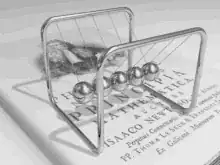We know wave is just a transmission of energy. In case of mechanical wave, this transmission of energy requires a medium so that the particles of medium can help in transfer of energy.
Let us think of a string of particles which are equally spaced out that is uniformly distributed on the string. Name those particles alphabetically from A to Z from one end of the string. Now I want to create a wave with this string. So with the help my two fingers I lifted the 1st particle that is te A particle. Now because of the attraction force between A and B, B moves upward a little bit. Similarly C and D. also moved a little bit upward. When I released the particle A, due to elasticity (ignoring gravity) it tries to move to its equilibrium position (ignore resistances). But the B particle moves a bit more upward at a height where A was initially when it was lifted, due to inertia. In this way a wave is formed and propagates along the string. Now suppose I stopped the particle by holding it firmly. So it is certain that since I resisted the oscillation of E, the wave energy will not be able to reach F. I guess I got it right upto this. I thought of this because initially B wasn't oscillating but when I started to lift A, B also initiated oscillation. So it seems that the spontaneous oscillation of a particle depends on the precedent one unless there is any external force applied. I don't exactly know whether this is correct or not but it seemed intuitively correct.
Now moving on to the main part of the question. In a standing wave intially a travelling wave progresses and then refelcts back to superimpose with the 1st wave (the traveling wave not the reflected one which will be referred as the 2nd wave from now on). Both of these waves are continuous( basically the 1st wave). In case of standing wave we know some nodal points are formed where there is no oscillation. Ao my question is that if a nodal point is formed then how does energy propagate to the succeeding particle? I mean previously we noticed that wave energy is not able to progress towards a particle when the preceeding particle isn't oscillating (considering there is no external forces applied on the particle we are dealing with).
Please help me figure out this problem. I have asked a bunch of people but could not get any satisfying answer.
If there is anything wrong about fundamentals that I have known then please help me to understand where I am wrong.
